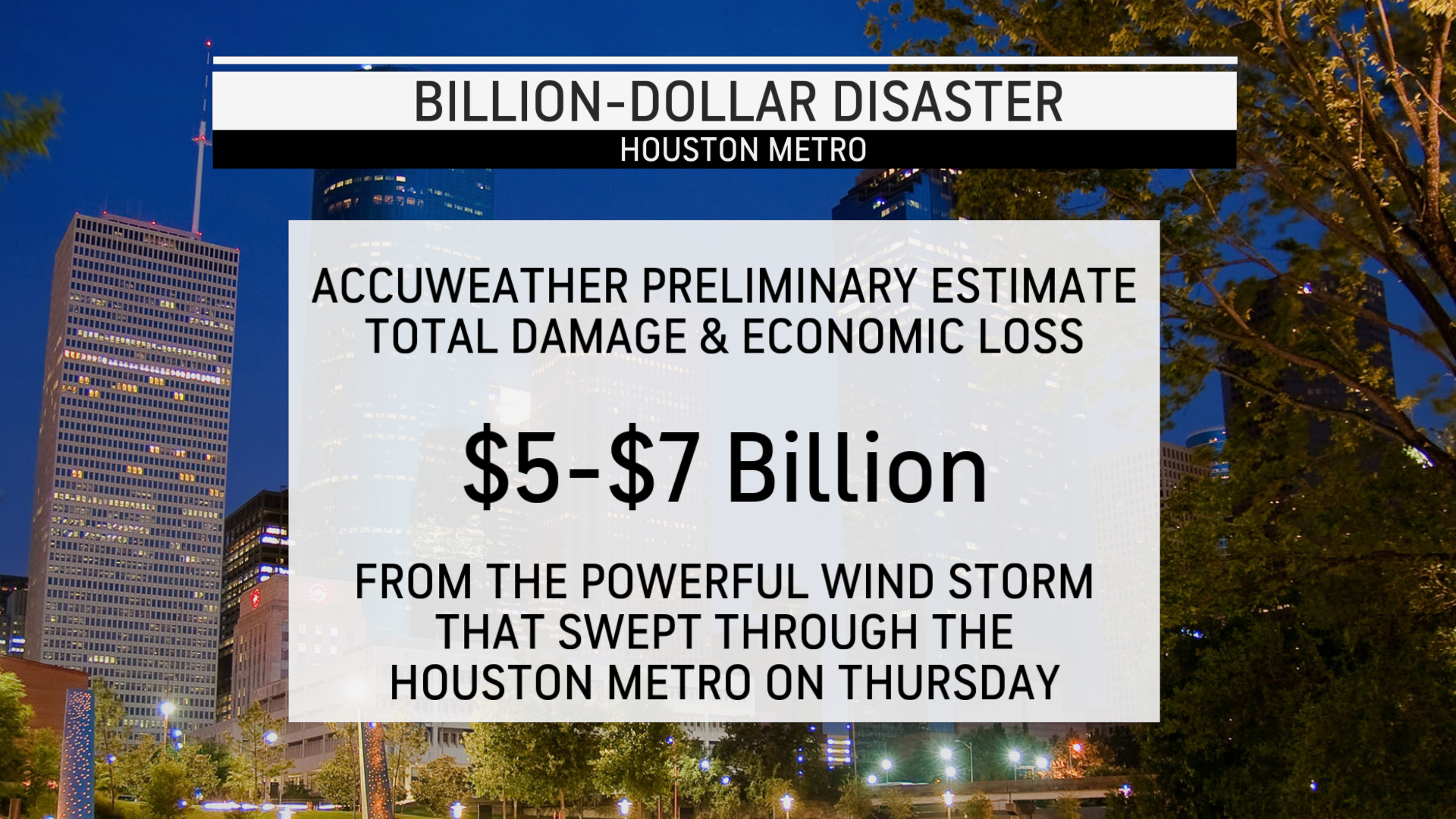AccuWeather meteorologists are available 24/7 to provide further insights and updates on evolving weather conditions. Please contact pr@accuweather.com during regular business hours, or support@accuweather.com or call AccuWeather’s Media Hotline at (814)-235-8710 at any time to arrange interviews with AccuWeather experts or to request the most updated graphics for print or broadcast.
AccuWeather’s Preliminary Estimate of the Total Damage and Economic Loss from Windstorm in Houston Metro is $5-7 Billion
|
|||||||||||
May 17, 2024
AccuWeather Global Weather Center – May 17, 2024
A powerful windstorm that slammed downtown Houston with hurricane-force winds Thursday evening brought life-threatening hazards to more than two million people and has left hundreds of thousands of families without power and air conditioning.
AccuWeather’s preliminary estimate of the total damage and economic loss from the windstorm in southeast Texas is $5-7 billion.
AccuWeather’s damage estimate incorporates independent methods to evaluate direct and indirect impacts of the storm, includes both insured and uninsured losses, and is based on a variety of sources, statistics, and unique techniques AccuWeather uses to estimate the damage, to property, job and wage losses, crops, infrastructure damage, interruption of the supply chain, auxiliary business losses and flight delays or cancellations. The estimate also accounts for the costs of evacuations, relocations, emergency management, and the government expenses for cleanup operations. It also includes the long-term effect on business logistics, transportation, tourism as well as the tail health effects and the medical and other expenses of yet unreported deaths and injuries.

The destructive windstorm blew out windows in high-rise buildings, flipped trucks on the highway, and brought down trees onto homes and parked vehicles across the region. Large transmission towers and power lines also came down in the storm, which will require lengthy and expensive repairs.
“This was an incredibly dangerous and destructive storm, impacting one of the largest cities and busiest travel hubs in America,” said AccuWeather Chief Meteorologist Jonathan Porter. “Downtown Houston has not seen wind damage like this since Hurricane Ike in 2008 and Hurricane Alicia in 1983. This windstorm will go down in the history books as one of the most damaging storms in modern Houston history that was not caused by a hurricane.”
Thousands of businesses are facing long-lasting impacts due to damaged vehicles and equipment, as well as roof and window damage to office and warehouse buildings. Extended connectivity and power outages have also led to a loss of business and goods that require refrigeration. Damage may have occurred to tens of thousands of homes and apartments.

"Many high-rise skyscraper windows were shattered in parts of the downtown Houston area. Distributive winds near the ground were even higher just above the ground, as there is less friction from buildings and trees which slow the winds at ground level,” Porter explained. “By using the wind power law, AccuWeather experts say a measured wind gust of 71 mph at 33 feet, over a coverage of many trees and occasional buildings where the measurement was, would equate to 80 mph winds at 60 feet (around 6 stories up) and 90 mph winds at 100 feet (around 10 stories up). Likewise, if we assume winds of 85 mph at 33 feet, that would equate wind gusts of 96 mph at 60 feet (around 6 stories up) and 107 mph at 100 feet (around 10 stories up). 30 stories up, winds could have gusted to near 150 mph. A full damage assessment from the National Weather Service may be needed to properly estimate the severity of the winds in Houston."
"This powerful windstorm caused extensive damage just two weeks before the official start of hurricane season. This volatile storm is an important reminder for everyone along the Gulf Coast to be prepared for extreme weather,” warned Porter. “Texans have dealt with relentless rounds of flooding and tornado threats in recent weeks. We know it’s been tiring, but it’s important that everyone is prepared for tropical threats. The Texas and Louisiana coastlines are both at a heightened risk for hurricane impacts this year.”
“Though this windstorm was completely different from a meteorological perspective than a hurricane, people in the Houston area may have felt like they experienced a brief “mini-hurricane” since the damage looks similar to that which might be experienced from the wind impacts of a Category 1 hurricane on the Saffir-Simpson scale,” said Porter.
Rising Temperatures & Safety Hazards After The Storm
In addition to the immediate life-threatening hazards during the storm, AccuWeather expert meteorologists are concerned about public safety with rising temperatures in the forecast this weekend.
AccuWeather RealFeel temperatures are forecast to reach 100 degrees in Houston this weekend, where hundreds of thousands of people will be without electricity and air conditioning.
The forecast for Sunday’s high temperature in Houston could tie or break the record high temperature of 94 degrees set in 2008.
Contractors, emergency responders, volunteers, and homeowners working to clean up the storm damage and make repairs are urged to stay hydrated, take breaks in the shade, and wear appropriate clothing and shoes to avoid heat-related illness or injuries.
AccuWeather expert meteorologists are also reminding people to use extra caution while using generators, and to ensure there is proper ventilation for exhaust fumes. Improper use of generators after storms can lead to carbon monoxide poisoning, electrocution, and even fires.
“We’ve seen so many unnecessary tragedies after widespread power outages like this when people try to operate generators unsafely,” said Porter. “People understandably get desperate for power when those outages last days or weeks. Please use extra caution when relying on generators. We need to avoid any additional tragedies in this situation.”
To put this event into context, Hurricane Idalia caused an estimated $18-20 billion in damage and economic losses in the southeast United States. Tropical Storm Hilary caused an estimated $7-9 billion in damage and economic losses in the western U.S. last August. Impacts from Hurricane Nicole in November 2022 caused an estimated $5-7 billion in damage and economic losses in Florida. As such, it is important to point out that this intense windstorm traversing the heavily populated Houston area over an hour and a half produced as much total damage and economic loss as hurricane impacting much of Florida, making landfall as a Category 1 hurricane on the Saffir-Simpson scale.
The Midwest Derecho of August 2020 caused an estimated $11.2 billion in damage and economic losses over a multi-state area. Hurricane Harvey caused $230 billion, adjusted for inflation, along the Gulf Coast in 2017. Most of the damage from Harvey was caused by extreme flooding in the Houston metro.
Additional AccuWeather Resources:















